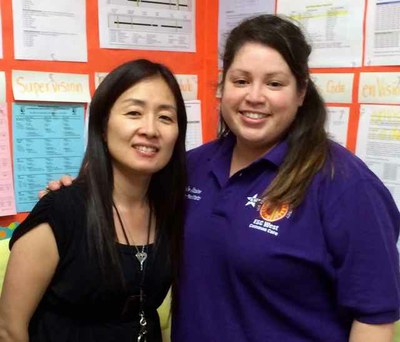Monitoring and Supporting English Learners
“There is no equality of treatment merely by providing students with the same facilities, textbooks, teachers, and curriculum; for students who do not understand English are effectively foreclosed from any meaningful education...We know that those who do not understand English are certain to find their classroom experiences wholly incomprehensible and in no way meaningful.” --Lau vs. Nichols
 Overview
Overview
Of the 651 students at the school, 53% have been identified as English Language Learners (ELLs). That is, 53% of the school’s students speak a language other than English at home, and upon receipt of scores of the California English Language Development Test (CELDT), have been identified as needing targeted English Language support. Based on their scores from the test, students are assigned a level (1-5), each with a set of skills that must be mastered before proceeding to the next level. Students who have been identified as ELLs are then enrolled in Structured English Immersion (SEI) classrooms as Limited English Proficient Students (LEP), and their progress monitored, with the express intent of having them master the necessary language skills and exit (reclassify) the ELD program as Reclassified Fluent English Proficient students (RFEP).
Several norms have been put in place to ensure the success of this subgroup of students. In order to oversee the students’ progress in English Language Development (ELD), level-specific portfolios are assigned to each student. Instructors use the skills and standards of their students’ levels to inform ELD instruction and necessary student work to include in the portfolio as evidence of mastery of the skills. The portfolios, with the student work included, are then given to the Categorical Programs Advisor to review.
Students who have been identified as ELLs, and have been receiving targeted support for 5 years without reclassifying become members of a subgroup, and are designated Long Term English Learners (LTELs). Because the success of this subgroup is still paramount, meetings with parents and students are established to better facilitate their learning.
Aside from monitoring their progress through the ELD portfolio system, these students also receive support in the form of data-driven intervention and tutoring programs, during the instructional day, after school, and summer break.
Key Responsibilities
- CELD site coordinator: secure all testing materials, train all examiners/proctors, score initial exams, input data into SIS, send initial results for parents, pack/deliver annual and initial tests (September/October 2013)
- Complete and submit all monthly English Learner Accountabilities (due at the end of each calendar month)
- Collect and review ELD Portfolios and provide teachers with appropriate feedback in order to monitor English Learners’ adequate yearly progress toward Reclassification
- Manage and support the Language Appraisal Team (LAT) and Long Term English Learner (LTEL) Designee with monitoring of English Learners not making adequate yearly progress
- Support English Learners not making adequate yearly progress by developing and implementing appropriate intervention/tutoring programs
- Maintain accurate records and communicate student progress to parents of English Learners
 Reflection
Reflection
As the Categorical Programs Advisor, my goal was to do everything in my power to facilitate the progress of those students enrolled in the SEI program at my school site.
I took my cues from the many minds that authored the Common Core State Standards: work backward. Ensuring the success of these students meant going beyond my own monitoring responsibilities, I had to ensure I built campus-wide capacity.
I revised the portfolio review process in order to facilitate turn ins. Teachers have so many responsibilities as it is, I wanted to make sure that ELD portfolio reviews were as streamlined and transparent as possible. I took the time to inform teachers of my approach: I would ask that teachers band those students they thought were ready to either move up or reclassify, I also asked teachers to include multiple work samples in order to paint a clearer pictures of student progress, and I would ask that each teacher grade each standard assessed individually. In turn, I would provide teachers with labels with the standards printed on them to adhere to the student work samples, I would include progress monitoring rosters with comments (e.g., calling attention to a student that may be close to reclassifying), I would make sure there were memos reminding teachers of upcoming due dates, and should they have missed the turn-in date, I would follow up with a reminder memo.
Teacher’s Assistants were next. I made sure that they were given multiple opportunities to be trained in several intervention programs that would help our ELLs achieve proficiency in English Language Arts. And because monitoring and evidence of monitoring is key, I created and trained them in the use of, an intervention attendance/hour log for the purposes of ELD progress monitoring and monitoring our ELLs’ Response to Instruction and Intervention (RTI2).
 Finally came the students. I had already established norms that would facilitate the faculty and staff’s capacity, I also worked to make sure that the students themselves received every attention and opportunity to progress and reclassify. In-school intervention was already established, but there was the time outside of school to think about.
Finally came the students. I had already established norms that would facilitate the faculty and staff’s capacity, I also worked to make sure that the students themselves received every attention and opportunity to progress and reclassify. In-school intervention was already established, but there was the time outside of school to think about.
Research shows that without proper stimulation, some of what has been learned during the academic year is forgotten during the summer. How then could I ensure that students performed at their best on the CELDT, which is administered at the beginning of the year? I developed a “CELDT Boot Camp” to take place in the weeks leading up to the beginning of the new school year, a task that necessitated further teacher training, and coordinating.
It is a credit to the faculty and staff at the school that the norms I established continue in my absence.
I was particularly anxious to help those ELLs who had become LTELs. District requirements stipulated that teachers, parents and students be made aware of what LTEL status entailed. Because balancing the schedules of teachers, the LTEL Designees, and parents could be difficult, it was incumbent upon me to find a solution that was efficient for all involved. With the help of the LTEL Designee, I coordinated with those teachers who had LTELs in their classrooms to set up times either before or after parent/teacher conference appointments to discuss the student’s progress with all the necessary parties present.
CPSEL Connection
Standard 1 - A school administrator is an educational leader who promotes the success of all students by facilitating the development, articulation, implementation, and stewardship of a vision of learning that is shared and supported by the school community.
Standard 2 - A school administrator is an educational leader who promotes the success of all students by advocating, nurturing, and sustaining a school culture and instructional program conducive to student learning and staff professional growth.
Standard 3 - A school administrator is an educational leader who promotes the success by ensuring management of the organization, operations, and resources for a safe, efficient, and effective environment.
Standard 4 - A school administrator is an educational leader who promotes the success of all students by collaborating with families and community members, responding to diverse community interests and needs, and mobilizing community resources.
Standard 5 - A school administrator is an educational leader who promotes the success of all students by modeling a personal code of ethics and developing professional leadership capacity.
Standard 6 - A school administrator is an educational leader who promotes the success of all students by understanding, responding to, and influencing the larger political, social, economic, legal, and cultural context.
Supporting Documents
ELD Schedule, Portfolio Feedback, Due Dates Memo and Reminder, ELD Portfolio Review Checklist, EL Monitoring Roster with Feedback, and AMAO Requirements Certification Form

